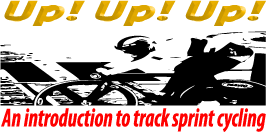04 - progressive overload and cadence targeting
As the summary above says, to go faster you need to pedal faster and/or push harder. That's a gross simplification, but is absolutely true. Different riders will favour one over the other, big, strong riders may lean towards pushing harder (more torque, lower revs) while the leaner riders generally will prefer to pedal faster. Because as sprint cyclists we can't change gears mid-race, this makes things interesting.
We're going to explain one way to do this using progressive overload, applying a strength training principle to sprint cycling. It revolves around generating more torque per pedal stroke through a range of cadences. It is our opinion that each rider has a maximum useful cadence at which they can generate any sort of useful power and that's quite a lot lower than a resistance-free cadence such as is seen on an unlaiden ergo bike. There may be some relationship between a maximum unlaiden cadence and this useful maximum, but at the time of writing there is little evidence to suggest anything solid.
So, the basic idea :
For a particular effort, let's say a flying 200 as it's pretty relevant to us, we'll choose a target peak cadence - as a very rough suggestion, this can be 160rpm for a junior male (14-16 years old on age group restricted gearing) or 150 for a junior female, by starting using a low gear, and measuring peak cadences during the effort, ride a flying 50, and see if the target cadence is met on a small gear, progressively increase the gear until the target cadence can no longer be met. That gear will be pretty close to the best gear that the rider can push for that effort and still achieve the desired cadence.
This can also be used for other types of efforts, for example motorbike or rolling accelerations. The aim being to achieve a target cadence as quickly as possible, and increasing the gear until this is not met, then focusing on increasing the torque that the rider can produce to achieve the target cadence through training.
This is a reliable way to make gear choices during training efforts and the gears chosen can then also be used on race day as appropriate.
The really interesting question is what is the ideal cadence for sprint events?
In the "old days", sprinters were expected to spin at 160 or more RPM during the flying 200, recent studies and experience suggests that this high cadence is unobtainable for many sprint cyclists except for a few very genetically gifted athletes. Very high cadences also result in rapid fatigue as it appears that contraction count is of more importance than work done for sprint-intensity activities. Current trends in the mid 2010's are towards bigger gears and much lower cadences. Eddie Dawkins rode a 9.8 second flying 200 at the new AvantiDrome in Canterbury (sea level), New Zealand in winter (August 2014) on a 135" gear, with video showing 19.5 revolutions for the 200 meters. This is a cadence of around 119rpm. Anecdotal experience with trying "unthinkably" large gears even on juniors, masters and relatively weak sprinters has shown considerable improvement in flying 200's. Don't be afraid to experiment with gears that might be considered to be insanely big and very low target cadences.
